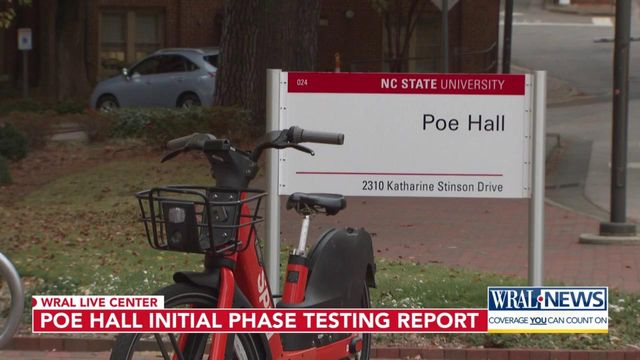NC State releases initial PCB test results from Poe Hall assessment, exceeding EPA limits in one area
North Carolina State University has released the first report of polychlorinated biphenyl (PCB) test results Thursday from Geosyntec Consultants, the consulting firm doing the environmental assessment of Poe Hall.
Poe Hall closed in Nov. 2023 after preliminary testing revealed high levels of PCBs, toxic chemicals linked to cancer.
In the months that followed, 99 people who worked or were students at Poe Hall, told 5 On Your Side they were diagnosed with some form of cancer.
In an update associated with the report released on the university’s website, officials highlighted some of the test results, as well as next steps.
The report showed only one test reading above EPA limits, however a Toxicologist pointed out to 5 On Your Side that the sampling was done with the HVAC system off and is not reflective of the scenario in which people were exposed to possible contaminants in Poe Hall.
That type of testing is planned for later states of the investigation.
Here are some of the highlights from the first round of testing:
- 14 indoor air samples did detect the PCB known as Aroclor-1262, but the university said all levels were below EPA exposure levels for PCBs in schools. It is important to remember that the HVAC system has been off since November 2023 and remained off throughout the testing. This means no dust particles of any kind were circulating through the air handler system.
- 67 surface, or swipe samples were taken throughout all seven of Poe Hall’s floors. Samples were taken from desktops, books, bathroom counters, air supply vents and several other locations. 25 wipe samples detected Aroclor-1262, but the report says only one was above EPA threshold.
According to NC State’s overview of the report, both air and surface samples were low overall. However, the highest readings from preliminary testing in October and November came from “bulk” tests. Bulk test results are not included in Geosyntec’s first report.
According to the EPA, bulk solid sampling typically includes removing a small portion of the potentially contaminated material for analytical testing. For example, a caulk sample would be the quantity of caulk needed by the laboratory for analytical testing, removed directly from the suspect area.
Testing in October showed bulk samples taken in the 5th floor women’s bathroom were 38 times EPA limits, and other bulk samples tested high for PCBs. Recommendations in the new report from Geosyntec indicate bulk samples of potential sources will be collected and analyzed, notably focused on the HVAC system.
Geosyntec recommends turning on the HVAC system to do more air and surface wipe sampling after bulk samples are analyzed.
The final recommendation in the report is to review studies on PCBs to understand the potential human health effects associated with exposure.













